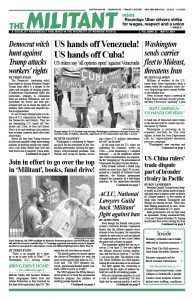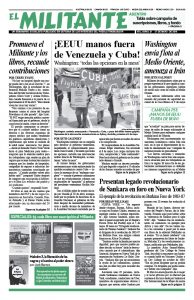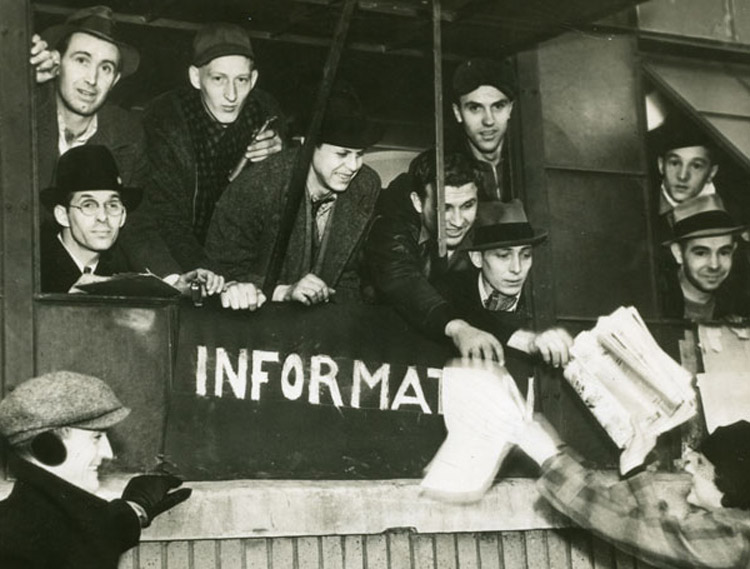This week’s Books of the Month excerpt is from The Long View of History, a pamphlet by George Novack. The author of a number of titles on U.S. working-class history and Marxist philosophy, Novack was a member and leader of the Socialist Workers Party from 1933 until his death in 1992. He also led several defense campaigns for victimized party members and others. This pamphlet explains how revolutionary change is fundamental to social and cultural progress and why the working class struggle to end capitalist exploitation is the only road forward. Copyright © 1960 by Pathfinder Press. Reprinted by permission.
In its evolution to our own century, civilized society can be divided into three main epochs: slavery, feudalism, and capitalism. Each of these is marked off by the special way in which the ruling propertied class at the head of the social setup manages to extract the surplus wealth upon which it lives from the laboring mass who directly create it. This entire period covers little more than the past five to six thousand years.
Civilization was ushered in and raised upon direct slavery. The very economic factors that broke up barbarism and made civilized life possible likewise provided the material preconditions for the use of slave labor. The division of labor based upon tending herds, raising crops, mining metals, and fashioning goods for sale enabled the most advanced societies to produce more than the actual laborers required for their maintenance. This made slavery both possible and profitable for the first time. It gave the most powerful stimulus to the predatory appetites of individual possessors of the means of production who strove to acquire and increase their surpluses of wealth. Slave production and ownership became the economic foundation of a new type of social organization, the source of supreme power, prestige, and privileges. And it eventually reshaped the whole structure of civilized life. …
But if slavery had sufficient reasons for becoming the beginning and basis of ancient civilization, in turn and in time it generated the conditions and forces which would undermine and overthrow it. Once slavery became the predominant form of production either in industry, as in Greece, or in agriculture, as in Rome, it no longer furthered the development of agricultural techniques, craftsmanship, trade, or navigation. The slave empires of antiquity stagnated and disintegrated until after a lapse of centuries they were replaced by two main types of feudal organization: Asiatic and West European.
As the result of a long list of technological and other social advances, merging with a sequence of exceptional historical circumstances, feudalized Europe became the nursery for the next great stage of class society, capitalism. How and why did capitalism originate?
Once money had arisen from the extension of trading several thousand years ago, its use as capital became possible. Merchants could add to their wealth by buying goods cheap and selling them dear; moneylenders and mortgage holders could gain interest on sums advanced on the security of land or other collateral. These practices were common in both slave and feudal societies.
But if money could be used in precapitalist times to return more than the original investment, other conditions had to be fulfilled before capitalism could become established as a separate and definite world economic system. The central condition was a special kind of transaction regularly repeated on a growing scale. Large numbers of propertyless workers had to hire themselves to the possessors of money and the other means of production in order to earn a livelihood. …
The industrial age was launched around the beginning of the nineteenth century with the application of steam power to the first mechanized processes, concentrating large numbers of wage workers into factories. The capitalist captains of this large-scale industry became masters of the field of production and later of entire countries and continents as their riches, their legions of wage laborers, social and political power, swelled to majestic proportions.
This vigorous, expanding, progressive, confident, competitive stage of industrial capitalism dominated the nineteenth century. It passed over into the monopoly-ridden capitalism of the twentieth century, which has carried all the basic tendencies of capitalism, and especially its most reactionary features, to extremes in economic, political, cultural, and international relations. While the processes of production have become more centralized, more rationalized, more socialized, the means of production and the wealth of the world have become concentrated in giant financial and industrial combines. So far as the capitalist sectors of society are involved, this process has been brought to the point where the capitalist monopolies of a single country, the U.S., dictate to all the rest. …
In the last century, Marx made a scientific analysis of the workings of the capitalist system which explained how its inner contradictions would bring about its downfall. The revolutions of our own century since 1917 are demonstrating in real life that capitalism is due to be relegated to the museum of antiquities. It is worthwhile to understand the inexorable underlying causes of these developments, which appear so inexplicable and abhorrent to the upholders of the capitalist system.
Capitalism has produced many things, good and bad, in the course of its evolution. But the most vital and valuable of all the social forces it has created is the industrial working class. The capitalist class has brought into existence a vast army of wage laborers, centralized and disciplined, and set it into motion for its own purposes, to make and operate the machines, factories, and all the other production and transportation facilities from which its profits emanate. …
The struggle between these conflicting social classes is today the dominant and driving force of world and American history, just as the conflict between the bourgeois-led forces against the precapitalist elements was the motivating force of history in the immediately preceding centuries.


